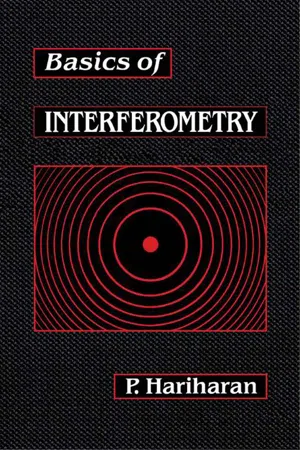![]()
Chapter 1
Introduction
Publisher Summary
Phenomena caused by the interference of light waves can be seen all around us. Some of the current applications of optical interferometry are the accurate measurements of distances, displacements, and vibrations; the tests of optical systems; the studies of gas flows and plasmas; the measurements of temperature, pressure, electrical, and magnetic fields; rotation sensing; and high-resolution spectroscopy. Several new developments have extended the scope and accuracy of optical interferometry and they make the use of optical interferometry practical for a very wide range of measurements. The most important of these new developments has been the invention of laser. Lasers have removed many of the limitations imposed by conventional sources and have made possible many new interferometric techniques.
Phenomena caused by the interference of light waves can be seen all around us: typical examples are the colors of an oil slick or a thin soap film.
Only a few colored fringes can be seen with white light. As the thickness of the film increases, the optical path difference between the interfering waves increases, and the changes of color become less noticeable and finally disappear. However, if monochromatic light is used, interference fringes can be seen with quite large optical path differences.
Since the wavelength of visible light is quite small (approximately half a micrometre for green light), optical interferometry permits extremely accurate measurements and has been used as a laboratory technique for almost a hundred years. Several new developments have extended its scope and accuracy and have made the use of optical interferometry practical for a very wide range of measurements.
The most important of these new developments was the invention of the laser. Lasers have removed many of the limitations imposed by conventional sources and have made possible many new interferometric techniques. New applications have also been opened up by the use of single-mode optical fibers to build analogs of conventional interferometers. Yet another development that has revolutionized interferometry has been the increasing use of photodetectors and digital electronics for signal processing.
Some of the current applications of optical interferometry are accurate measurements of distances, displacements and vibrations, tests of optical systems, studies of gas flows and plasmas, microscopy, measurements of temperature, pressure, electrical and magnetic fields, rotation sensing, and high resolution spectroscopy. There is little doubt that in the near future many more will be found.
![]()
Chapter 2
Interference: A Primer
Publisher Summary
This chapter discusses light waves. Light can be thought of as a transverse electromagnetic wave propagating through space. As the electric and magnetic fields are linked to each other and propagate together, it is usually sufficient to consider only the electric field at any point; this field can be treated as a time-varying vector perpendicular to the direction of propagation of the wave. If the field vector always lies in the same plane, the light wave is said to be linearly polarized in that plane. The chapter describes intensity in an interference pattern. When two light waves are superposed, the resultant intensity at any point depends on whether they reinforce or cancel each other. This is the well-known phenomenon of interference. This chapter discusses the localization of fringes. When an extended quasi-monochromatic source, such as a mercury vapor lamp with a monochromatic filter, is used instead of a monochromatic point source, interference fringes are often observed with good contrast only in a particular region. This phenomenon is known as the localization of fringes and is related to the lack of coherence of illumination.
This chapter discusses some basic concepts.
• Light waves
• Intensity in an interference pattern
• Visibility of interference fringes
• Interference with a point source
• Localization of interference fringes
2.1 Light Waves
Light can be thought of as a transverse electromagnetic wave propagating through space. Because the electric and magnetic fields are linked to each other and propagate together, it is usually sufficient to consider only the electric field at any point; this field can be treated as a time-varying vector perpendicular to the direction of propagation of the wave. If the field vector always lies in the same plane, the light wave is said to be linearly polarized in that plane. We can then describe the electric field at any point due to a light wave propagating in a vacuum along the z direction by the scalar equation
where a is the amplitude of the light wave, v is its frequency, and λ is its wavelength. Visible light comprises wavelengths from 0.4 μm (violet) to 0.75 μm (red), corresponding to frequencies of around 7.5 × 1014 Hz and 4.0 × 1014 Hz, respectively. Shorter wavelengths lie in the ultra violet (UV) region, while longer wavelengths lie in the infrared (IR) region.
Th...

